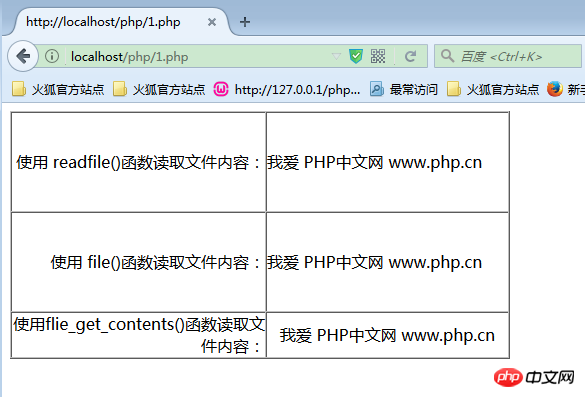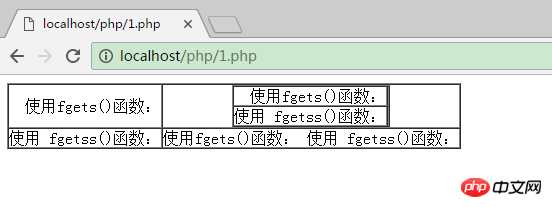PHP file handling - how to read a file (one line, whole file)
PHP file processing—how to read a file (one line, the entire file)
Reading and writing files is more complicated than opening and closing files. Here we mainly explain from two aspects: reading data and writing data.
Then in the previous article "PHP File Processing - Opening and Closing Files", opening and closing files was introduced. Opening files is the prerequisite for all file operations, and closing is the prerequisite for all operations. The end of the file, then today we will introduce how to read the file!
Read data from the file
Read data from the file, you can read a character, a line of string or the entire file , you can also read a string of specified length.
1. Read the entire file: readfile(), flie() and file_get_contents() three functions, we will introduce them one by one below!
readfile() function
The readfile() function is used to read a file and write it to the output buffer. If an error occurs, it returns false. The function syntax format is as follows:
int readfile ( string $filename [, bool $use_include_path = false [, resource $context ]] )
Using the readfile() function, there is no need to open and close the file, and there is no need for echo, print and other output statements. Just write the file path first.
flie() function
flie() function can also read the contents of the entire file, but the file() function stores the file contents into an array line by line. Including newlines, returns false if the read fails. The syntax format of the function is as follows:
array file ( string $filename [, int $flags = 0 [, resource $context ]] )
file_get_contents() function
file_get_contents() function reads the contents of the file (fliename) into a string. If there are no offset and maxlen parameters, a string of length maxlen will be read starting from the position specified by the offset parameter. If the read fails, false will be returned. The function syntax format is as follows;
string file_get_contents ( string $filename [, bool $use_include_path = false [, resource $context [, int $offset = -1 [, int $maxlen ]]]] )
This function is suitable for binary files and is the preferred method to read the entire file content into a string.
The following example uses the above three functions to read the file content separately. The specific code is as follows:
<html>
<body>
<table width="500" border="1" cellpadding="0" cellspacing="0" >
<tr>
<td width="253" height="100" align="right" valign="middle" scope="col">使用 readfile()函数读取文件内容:</td>
<td width="241" height="100" valign="middle" scope="col">
<!--使用 readfile()函数读取tm.txt文件内容-->
<?php readfile("tm.txt");?></td>
</tr>
<tr>
<td height="100" align="right" valign="middle">使用 file()函数读取文件内容:</td>
<td height="100" valign="middle" >
<!--使用 file()函数读取tm.txt文件内容-->
<?php
$f_arr = file("tm.txt");
foreach ($f_arr as $cont){
echo $cont."<br>";
}
?>
</td>
</tr>
<tr>
<td width="250" height="25" align="right" valign="middle" scope="col">使用flie_get_contents()函数读取文件内容:</td>
<td height="25" valign="middle" align="center" scope="col" >
<!--使用 flie_get_contents()函数读取tm.txt文件内容-->
<?php
$f_chr = file_get_contents("tm.txt");
echo $f_chr;
?>
</td>
</tr>
</table>
</body>
</html>The output result is:

2. Read a row of data: fgets() function and fgetss() function
(1) fgets() function
fgets() function is used to read one row of data at a time. The function syntax is as follows:
string fgets ( resource $handle [, int $length ] )
The parameter handle is the file to be read, and the parameter length is the length of the data to be read. The function can read a line from the file specified by handle and return a string with a maximum length of length-1 bytes. Stops with newline character, EOF or after reading length-1 times. If the length-1 parameter is omitted, data is read until the end of the line.
(2)fgetss() function
The fgetss() function is a variant of the fgets() function and is used to read a row of data. At the same time, the fgetss() function will filter out HTML and PHP tags in the content being read. The function syntax is as follows:
string fgetss ( resource $handle [, int $length [, string $allowable_tags ]] )
This function can filter out any html and PHP tags from the read file. You can use the allowable_tags parameter to control which tags are not filtered out.
The following example uses the above function to read a file respectively and display it. Observe the difference between them. The specific code is as follows:
<html>
<body>
<table border="1" cellpadding="0" cellspacing="0" >
<tr>
<td align="right" valign="middle" scope="col">使用fgets()函数:</td>
<td valign="middle" scope="col" align="center">
<!--使用fgets()函数读取fun.php文件-->
<?php
$fopen = fopen("1.php","rb");
while (!feof($fopen)){
echo fgets($fopen);
}
fclose($fopen);
?></td>
</tr>
<tr>
<td align="right" valign="middle">使用 fgetss()函数:</td>
<td align="center" valign="middle" >
<!--使用fgetss()函数读取-->
<?php
$fopen = fopen("1.php","rb");
while (!feof($fopen)){
echo fgetss($fopen);
}
fclose($fopen);
?></td>
</tr>
</table>
</body>
</html>The output result is:

This article introduces two methods of reading files, one is to read the entire file, and the other is It reads one line of data. In the next article, I will introduce reading one character and a string of specified length. For details, please read "PHP File Processing—Reading File (One Character, String)》!
The above is the detailed content of PHP file handling - how to read a file (one line, whole file). For more information, please follow other related articles on the PHP Chinese website!

Hot AI Tools

Undresser.AI Undress
AI-powered app for creating realistic nude photos

AI Clothes Remover
Online AI tool for removing clothes from photos.

Undress AI Tool
Undress images for free

Clothoff.io
AI clothes remover

Video Face Swap
Swap faces in any video effortlessly with our completely free AI face swap tool!

Hot Article

Hot Tools

Notepad++7.3.1
Easy-to-use and free code editor

SublimeText3 Chinese version
Chinese version, very easy to use

Zend Studio 13.0.1
Powerful PHP integrated development environment

Dreamweaver CS6
Visual web development tools

SublimeText3 Mac version
God-level code editing software (SublimeText3)

Hot Topics
 1669
1669
 14
14
 1428
1428
 52
52
 1329
1329
 25
25
 1273
1273
 29
29
 1256
1256
 24
24
 PHP: A Key Language for Web Development
Apr 13, 2025 am 12:08 AM
PHP: A Key Language for Web Development
Apr 13, 2025 am 12:08 AM
PHP is a scripting language widely used on the server side, especially suitable for web development. 1.PHP can embed HTML, process HTTP requests and responses, and supports a variety of databases. 2.PHP is used to generate dynamic web content, process form data, access databases, etc., with strong community support and open source resources. 3. PHP is an interpreted language, and the execution process includes lexical analysis, grammatical analysis, compilation and execution. 4.PHP can be combined with MySQL for advanced applications such as user registration systems. 5. When debugging PHP, you can use functions such as error_reporting() and var_dump(). 6. Optimize PHP code to use caching mechanisms, optimize database queries and use built-in functions. 7
 PHP vs. Python: Understanding the Differences
Apr 11, 2025 am 12:15 AM
PHP vs. Python: Understanding the Differences
Apr 11, 2025 am 12:15 AM
PHP and Python each have their own advantages, and the choice should be based on project requirements. 1.PHP is suitable for web development, with simple syntax and high execution efficiency. 2. Python is suitable for data science and machine learning, with concise syntax and rich libraries.
 PHP and Python: Comparing Two Popular Programming Languages
Apr 14, 2025 am 12:13 AM
PHP and Python: Comparing Two Popular Programming Languages
Apr 14, 2025 am 12:13 AM
PHP and Python each have their own advantages, and choose according to project requirements. 1.PHP is suitable for web development, especially for rapid development and maintenance of websites. 2. Python is suitable for data science, machine learning and artificial intelligence, with concise syntax and suitable for beginners.
 PHP in Action: Real-World Examples and Applications
Apr 14, 2025 am 12:19 AM
PHP in Action: Real-World Examples and Applications
Apr 14, 2025 am 12:19 AM
PHP is widely used in e-commerce, content management systems and API development. 1) E-commerce: used for shopping cart function and payment processing. 2) Content management system: used for dynamic content generation and user management. 3) API development: used for RESTful API development and API security. Through performance optimization and best practices, the efficiency and maintainability of PHP applications are improved.
 The Enduring Relevance of PHP: Is It Still Alive?
Apr 14, 2025 am 12:12 AM
The Enduring Relevance of PHP: Is It Still Alive?
Apr 14, 2025 am 12:12 AM
PHP is still dynamic and still occupies an important position in the field of modern programming. 1) PHP's simplicity and powerful community support make it widely used in web development; 2) Its flexibility and stability make it outstanding in handling web forms, database operations and file processing; 3) PHP is constantly evolving and optimizing, suitable for beginners and experienced developers.
 PHP and Python: Different Paradigms Explained
Apr 18, 2025 am 12:26 AM
PHP and Python: Different Paradigms Explained
Apr 18, 2025 am 12:26 AM
PHP is mainly procedural programming, but also supports object-oriented programming (OOP); Python supports a variety of paradigms, including OOP, functional and procedural programming. PHP is suitable for web development, and Python is suitable for a variety of applications such as data analysis and machine learning.
 PHP vs. Other Languages: A Comparison
Apr 13, 2025 am 12:19 AM
PHP vs. Other Languages: A Comparison
Apr 13, 2025 am 12:19 AM
PHP is suitable for web development, especially in rapid development and processing dynamic content, but is not good at data science and enterprise-level applications. Compared with Python, PHP has more advantages in web development, but is not as good as Python in the field of data science; compared with Java, PHP performs worse in enterprise-level applications, but is more flexible in web development; compared with JavaScript, PHP is more concise in back-end development, but is not as good as JavaScript in front-end development.
 PHP and Python: Code Examples and Comparison
Apr 15, 2025 am 12:07 AM
PHP and Python: Code Examples and Comparison
Apr 15, 2025 am 12:07 AM
PHP and Python have their own advantages and disadvantages, and the choice depends on project needs and personal preferences. 1.PHP is suitable for rapid development and maintenance of large-scale web applications. 2. Python dominates the field of data science and machine learning.




